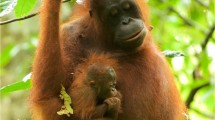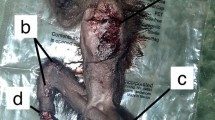Abstract
Ten cases of infant killings and 2 cases of juvenile killings were observed in two troops of Hanuman langurs, (Presbytis entellus) around Jodhpur, India. Fatal attacks on infants and juveniles are classified into four categories. The process of infanticide was observed from start to end and is described in detail for 3 cases. The age of the victims ranged from 0.2 to 48 months. The interbirth interval among females whose infants were killed is significantly shorter compared to females whose infants survived. In ourt study, 7 cases support the reproductive advantage hypothesis, that infanticide is an adaptive behaviour to increase male reproductive success. The remaining 5 cases do not fit into the reproductive advantage hypothesis. In these cases, victims are over 8 months old, and as such their deaths could not shorten the interbirth interval. It appears that by killing older infants and juveniles the males obtain an advantage in resource competition for their offspring. An alternative is that new males chase or peripheralise the older infants and juveniles, which leads to 97% predominant uni-male troop structure in Jodhpur.
Similar content being viewed by others
References
Agoramoorthy G., 1989.Reproductive parameters and social changes in Hanuman langurs (Presbytis entellus) of Jodhpur. Unpublished Ph.D. Thesis. University of Jodhpur.
Agoramoorthy G., Mohnot S.M., Sommer V &Srivastava A., 1988.Abortions in free ranging Hanuman langurs (Presbytis entellus). — A Male induced strategy? Human Evolution, 3: 297–308.
Altmann J., 1974.Observational Study of Behavior: Sampling Methods. Behaviour, 49: 227–267.
Altmann J., 1980.Baboon Mothers and Infants. Harvard University Press, Cambridge, Mass.
Bishop N. H., 1975.Social Behavior of Langur Monkeys (Presbytis entellus) in a High Altitude Environment. Unpublished Ph.D. Thesis. University of California, Berkeley.
Bishop N. H., 1979.Himalayan langurs: Temperate Colobines, Journal of Human Evolution, 8: 251–281.
Boggess J., 1979.Troop Male Membership Changes and Infant Killing in Langurs (Presbytis entellus). Folia primatologica, 32: 65–107.
Boggess J., 1980.Intermale Relations and Troop Male Membership Changes in Langurs (Presbytis entellus) in Nepal. International Journal of Primatology, 1: 233–274.
Boggess J., 1982.Immature Male and Adult Male Interactions in Bisexual Langur (Presbytis entellus) Troops. Folia primatologica, 38: 19–38.
Busse C, &Hamilton W. J., 1981.Infant Carrying by Male Chacma Baboons. Science, 212: 1281–1283.
Butynski T. M., 1982.Harem-male Replacement and Infanticide in the Blue Monkey (Cercopithecus mitis stuhlmanni) in the Kibale forest, Uganda. American Journal of Primatology, 3: 1–22.
Chapman M. &Hausfater G., 1979.The Reproductive Consequences of Infanticide in Langurs: a Mathematical Model. Behavioral Ecology and Sociobiology, 5: 227–240.
Clarke M. R., 1983.Infant-Killing and Infant Disappearace following Male Takeovers in a Group of Freeranging Howling Monkeys (Alouatta palliata) in Costa Rica. American Journal of Primatology, 5: 241–247.
Curtin R. A., 1982.Range Use of Langurs in Highland Nepal. Folia primatologica, 38: 1–18.
Curtin R. A. &Dolhinow P., 1978.Primate Social Behaviour in a Changing World. American Scientist, 66: 468–475.
Dolhinow P., 1977.Normal Monkeys? American Scientist, 65: 266.
Fox L. R., 1975.Cannibalism in Natural Populations. Annual Review of Ecology and Systematics, 6: 87–106.
Hamilton W. D., 1964.The Genetical Evolution of Social Behaviour, part I and II. Journal of Theoretical Biology, 7: 1–51.
Hausfater G. &Hrdy S. B., 1984.Infanticide: Comparative and Evolutionary Perspectives. Aldine Publishing Company, New York.
Hausfater G. &Vogel C., 1982.Infanticide in Langur Monkeys (genus: Presbytis): Recent Research and a Review of Hypotheses. In: A. B. Chiarelli and R. S. Corruccini. eds. Advanced Views in Primate Biology, pp. 160–176. Springer, Berlin.
Hrdy S. B., 1974.Male-Male Competition and Infanticide among the Langurs (Presbytis entellus) of Abu, Rajasthan. Folia primatologica, 22: 19–58.
Hrdy S. B., 1977.The Langurs of Abu. Harvard University Press, Cambrdige, Mass.
Hrdy S. B., 1979.Infanticide among Animals: a Review, Classification and Examination of the Implications for the Reproductive Strategies of Females. Ethology and Sociobiology, 1: 13–40.
Jay P., 1965.The Common Langur of north India. In: I. De Vore, ed. Primate Behavior—Field Studies of Monkeys and Apes, pp. 197–249. Holt, Rinehart and Winston, New York.
Laws J. W. &Laws J., 1984.Social Interactions among Adult Male Langurs (Presbytis entellus) at Rajaji Wildlife Sanctuary. International Journal of Primatology, 5: 31–50.
Makwana S. C., 1979.Infanticide and Social Change in two Groups of the Hanuman langur (Presbytis entellus) at Jodhpur. Primates, 20: 293–300.
Makwana S. C. &Advani R., 1981.Social Changes in the Hanuman langur, Presbytis entellus, around Jodhpur. Journal of the Bombay Natural History Society, 78: 152–154.
Maynard Smith J., 1964.Group Selection and Kin Selection. Nature, 201: 1145–1147.
Mohnot S. M., 1971.Some Aspects of Social Changes and Infant-Killing in the Hanuman langur, Presbytis entellus (Primates: Cercopithecidae), in western India. Mammalia, 35: 175–198.
Mohnot S. M., 1974.Ecology and Behaviour of the Common Indian Langur, Presbytis entellus. Unpublished Ph. D. thesis. University of Jodhpur, Jodhpur.
Mohnot S. M., 1977.Peripheralisation of Weaned Male Juveniles in Presbytis entellus. In: D. J. Chivers and J. Herbert, eds. Recent Advances in Primatology, Vol. 1, pp. 87–91. Academic Press, London and New York.
Mohnot S. M., Dave V. K., Agoramoorthy G. &Rajpurohit L. S., 1984.Ecobehavioural Studies of the Hanuman langur, Presbytis entellus. Proceedings of the 2nd Annual Workshop of Man and the Biosphere Projects, pp. 96–98. Man & the Biosphere Programme, Government of India, New Dilhi.
Newton P., 1985.The Behavioural Ecology of Forest Hanuman langurs. Tiger Paper, 12: 3–7.
Newton P. 1986.Infanticide in an Undisturbed Forest Population of Hanuman langurs, Presbytis entellus. Animal Behaviour, 34: 785–789.
Parthasarathy M. D. & Rahaman H., 1974.Infant Killing and Dominance Assertion among the Hanuman langurs. Vth Congress of the International Primatological Society, August 21–24, 1974, in Nagoya, Japan: 35 (abstract).
Rajpurohit L. S. &Mohnot S. M., 1988.Fate of Ousted Male Residents of One-Male Bisexual troops of Hanuman Langurs (Presbytis entellus) at Jodhpur, Rajasthan (India). Human Evolution, 3: 309–318.
Rudran R., 1973.Adult Male Replacement in One-Male Troops of Purple-Faced Langurs (Presbytis senex senex), and its Effect on Population Structure. Folia primatologica, 19: 166–192.
Rudran R., 1979a.Infanticide in Red Howlers (Alouatta seniculus) of Northern Venezuela. VII Congress of the International Primatological Society, January 8–12, 1979, in Bangalore, India: 107–108 (abstract).
Rudran R., 1979b.The Demography and Social Mobility of a Red Howler (Alouatta seniculus) population in Venezuela. In: J. F. Eisenberg, ed. Vertebrate Ecology in the Northern Neotropics, pp. 107–126. Smithsonian Institution Press, Washington, D. C.
Schubert, G., 1982.Infanticide by Usurper Hanuman langur Males: a Sociobiological Myth. Social Science Information, 21: 199–244.
Sommer V., 1987.Infanticide among Free-Ranging Langurs (Presbytis entellus) at Jodhpur (Rajasthan/India): Recent Observations and a Reconsideration of Hypotheses. Primates, 28: 163–197.
Sommer V. &Mohnot S. M., 1985.New Observations on Infanticides among Hanuman langurs (Presbytis entellus) near Jodhpur (Rajasthan/India). Behavioral Ecology and Sociobiology, 16: 245–248.
Struhsaker T. T., 1977.Infanticide and Social Organisation in the Redtail Monkey (Cercopithecus ascanius schmidti) in the Kibale Forest, Uganda. Zeitschrift für Tierpsychologie, 45: 75–84.
Struhsaker T. T. &Leland L., 1985.Infanticide in a Patrilineal Society of Red Colobus Monkeys. Zeitschrift für Tierpsychologie, 69: 89–132.
Sugiyama Y., 1965a.Behavioural Development and Social Structure in Two Troops of Hanuman langurs (Presbytis entellus). Primates, 6: 213–247.
Sugiyama Y., 1965b.On the Social Change of Hanuman langurs (Presbytis entellus) in their Natural Condition. Primates, 6: 381–418.
Sugiyama Y., 1966.An Artificial Social Change in a Hanuman langur troop (Presbytis entellus). Primates, 7: 41–72.
Sugiyama Y., 1967.Social organization of Hanuman langurs. In: S. A. Altmann, ed. Social Communication among Primates, pp. 221–236. Chicago University Press. Chicago.
Trivers R., 1972.Parental Investment and Sexual Selection. In: B. Campbell, ed. Sexual Selection and the Descent of Man, pp. 136–179. Aldine Publishing Company, Chicago.
Vogel C., 1977.Ecology and sociology of Presbytis entellus. In: M. R. N. Prasad and T. C. Anand Kumar, eds. Use of Non-Human Primates in Biomedical Research, pp. 24–25. Indian National Science Academy, New Delhi.
Vogel C. &Loch H., 1984.Reproductive Parameters, Adult-Male Replacements, and Infanticide among Free-Ranging Langurs (Presbytis entellus) at Jodhpur (Rajasthan), India. In: G. Hausfater and S. Blaffer Hrdy, eds. Infanticide: Comparative and Evolutionary Perspectives, pp. 237–256. Aldine Publishing Company, New York.
Winkler P., 1981.Zur Öko-Ethologie freilebender Hanuman-Languren (Presbytis entellus entellus Dufresne, 1797) in Jodhpur (Rajasthan), Indien. Unpublished Ph. D. thesis. University of Göttingen.
Winkler P., 1984.The Adaptive Capacities of the Hanuman langur, and the Categorizing of Diet. In: D. J. Chivers, B. A. Wood and A. Bilsborough, eds. Food Acquisition and Processing in Primates, pp. 161–166. Plenum Press, New York.
Winkler P., Loch H. &Vogel C., 1984.Life History of Hanuman langurs (Presbytis entellus): Reproductive Parameters. Infant Mortality, and Troop Development. Folia primatologica, 43: 1–23.
Wolf K., 1980.Social Changes and Male Reproductive Strategy in Silvered Leaf Monkeys, Presbytis cristata, in Kuala Selangor, Peninsular Malaysia. American Journal of Physical Anthropology, 52: 294.
Author information
Authors and Affiliations
Rights and permissions
About this article
Cite this article
Agoramoorthy, G., Mohnot, S.M. Infanticide and juvenilicide in Hanuman langurs (Presbytis entellus) around Jodhpur, India. Hum. Evol. 3, 279–296 (1988). https://doi.org/10.1007/BF02435858
Received:
Accepted:
Issue Date:
DOI: https://doi.org/10.1007/BF02435858




